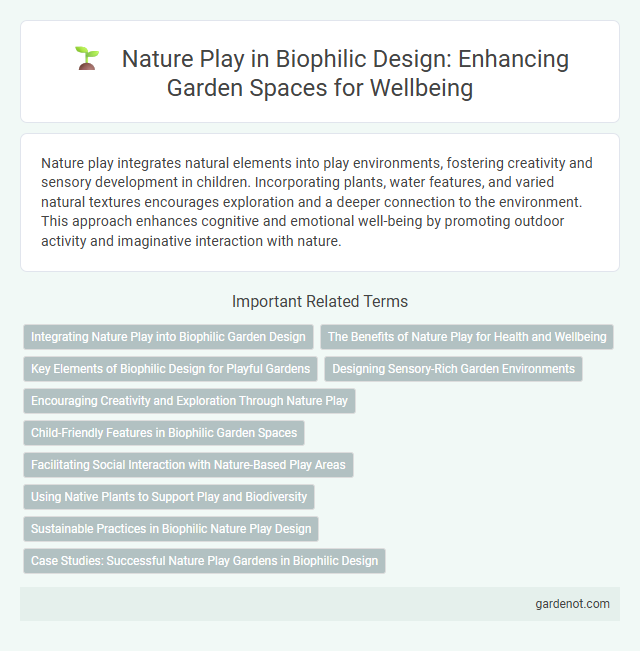Nature play integrates natural elements into play environments, fostering creativity and sensory development in children. Incorporating plants, water features, and varied natural textures encourages exploration and a deeper connection to the environment. This approach enhances cognitive and emotional well-being by promoting outdoor activity and imaginative interaction with nature.
Integrating Nature Play into Biophilic Garden Design
Integrating nature play into biophilic garden design enhances user engagement by incorporating natural elements such as logs, rocks, and water features that stimulate sensory exploration and imaginative play. Biophilic gardens prioritize native plant species and organic materials to create immersive environments fostering physical activity and cognitive development in children. Incorporating these elements supports biodiversity while promoting mental well-being through direct interaction with nature.
The Benefits of Nature Play for Health and Wellbeing
Nature play enhances physical health by encouraging outdoor activity, improving motor skills, and boosting immune function through exposure to natural environments. It supports mental wellbeing by reducing stress, increasing creativity, and fostering social connections among children and adults. Regular engagement with natural settings through play promotes emotional resilience and a deeper appreciation for biodiversity and environmental stewardship.
Key Elements of Biophilic Design for Playful Gardens
Incorporating natural materials, varied textures, and dynamic plant life fosters immersive sensory experiences essential for nature play in biophilic gardens. Features such as winding pathways, natural water elements, and interactive habitats encourage exploration and imaginative interaction. Emphasizing native flora and organic shapes supports biodiversity while promoting physical activity and cognitive development in children.
Designing Sensory-Rich Garden Environments
Designing sensory-rich garden environments in biophilic design emphasizes incorporating diverse natural elements such as textured plants, aromatic flowers, and varying tactile surfaces to stimulate multiple senses. Integrating features like water elements, bird feeders, and natural soundscapes enhances auditory engagement and encourages immersive nature play. These environments support cognitive development and emotional well-being by fostering direct interaction with nature's sensory diversity.
Encouraging Creativity and Exploration Through Nature Play
Nature play fosters creativity and exploration by immersing children in natural environments filled with diverse textures, colors, and shapes that stimulate sensory development. Elements such as logs, rocks, water, and plants encourage imaginative scenarios and problem-solving skills, promoting cognitive growth and emotional resilience. Integrating biophilic design principles in play spaces supports open-ended discovery, enhancing children's connection to nature and overall well-being.
Child-Friendly Features in Biophilic Garden Spaces
Child-friendly features in biophilic garden spaces enhance nature play by incorporating elements like natural textures, varied plant species, and interactive water features that stimulate sensory engagement and motor skills development. Thoughtfully designed pathways, shaded areas, and safe climbing structures encourage exploration and physical activity, fostering a deeper connection to the environment. Integrating biodiversity and natural materials promotes curiosity, creativity, and emotional well-being in young children within outdoor learning environments.
Facilitating Social Interaction with Nature-Based Play Areas
Nature-based play areas enhance social interaction by creating environments where children and adults engage collaboratively with natural elements like plants, water features, and loose materials. Integrating diverse sensory experiences in these spaces promotes communication, teamwork, and shared exploration, fostering community bonds. Research shows that biophilic design in play areas improves social skills and emotional well-being through immersive nature interaction.
Using Native Plants to Support Play and Biodiversity
Using native plants in biophilic design enhances nature play by creating diverse, interactive environments that support local biodiversity and stimulate children's sensory exploration. These plants provide natural habitats for pollinators and wildlife, fostering ecological balance while promoting educational opportunities through direct engagement with native ecosystems. Incorporating indigenous vegetation enriches play spaces with authentic textures, scents, and seasonal changes, deepening connections to the local environment and encouraging sustainable outdoor activity.
Sustainable Practices in Biophilic Nature Play Design
Sustainable practices in biophilic nature play design prioritize the use of natural, locally sourced materials such as reclaimed wood, stone, and native plants to minimize environmental impact and promote ecosystem health. Incorporating permeable surfaces and natural water management systems supports biodiversity and reduces runoff, enhancing the ecological function of play spaces. Designing with seasonal changes in mind encourages ongoing engagement while fostering environmental stewardship among children and communities.
Case Studies: Successful Nature Play Gardens in Biophilic Design
Nature play gardens in biophilic design, such as the Roger Williams Park Nature Playscape in Providence and the Natural Playscape at the California Academy of Sciences, demonstrate the integration of natural elements to promote child development and environmental stewardship. These case studies highlight the use of native plants, natural materials, and varied topography to create immersive, sensory-rich environments that encourage imaginative play and physical activity. Data from these sites indicate increased engagement and improved cognitive and social skills in children, reinforcing the benefits of nature-based play in educational and recreational settings.
Nature play Infographic

 gardenot.com
gardenot.com